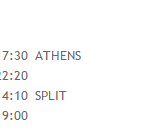Can Croatia become the new California of almonds? While nearly 80 percent of all almonds in the world are grown in California, Croatia grows close to nothing. With the trends in their favor, some Dalmatians are turning to agriculture instead of tourism to cultivate this fruit, reports T.portal on December 17, 2018.
Former national team basketball player Mate Miliša began growing almonds two years ago. It was then that he planted the first trees, and today they spread over 40 hectares in the area of Ravni Kotari and Bukovica in the Zadar County. He plans to reach 130 hectares of almonds in three years.
“I saw an excellent opportunity in this business, so I went in,” answers Miliša, the owner of Zrno Zdravlja who started his career as a basketball player at Zagreb’s Cibona, and later played in the US where he completed his management studies. Miliša then spent two years at Cedevita and four at Emil Tedeschi’s Atlantic Group. After leaving the Atlantic Group, he dedicated his life to a new business – agriculture.
“In agriculture, one should never lose sight of the fact that it is an outdoor factory, as it is often known to be called. It all depends on the weather, the ground, a combination of different factors,” he notes.
Before he stepped into the almond business, Miliša put the calculations down on paper. He then concluded that his investment could be paid off in six to seven years, depending on the price of the fruit. A kilogram of shelled almonds recently ranged between six and eight euro.
‘The price depends on the time of sale. During the harvest, at the end of August and early September, it is the lowest, and at this time of year, it starts to grow slowly. When we made a business plan, at the beginning of 2015, it was 20 percent lower than it is now. And how it will move forward, I am not sure. I hope it will go up, but I’m ready for it to drop,” Miliša says of 8-year calculations – though he could already be talking serious amounts in the next four years.
For this manufacturer, that is in 2020 when he plans to send off his first shipment.
“The market exists, and almonds are a stock market commodity. At the moment I have not signed a purchase agreement, but I have some preliminary arrangements with customers that will be able to offer more serious quantities of almonds in 2020,” he says.
According to Eurostat data, in the European Union in 2016, a total of 315,400 tons were produced on 689,640 hectares. Europe’s top production is held by Spain, which produces 198.770 tons of almonds on 583,670 hectares. In the same year, Croats imported 1006 tons of almonds and produced 160 tons on 430 hectares, of which 126 tons were exported, mostly in the countries of the region. A year later, in 2017, the export of almonds fell to 106 tons, and imports increased to 1067 tons.
“It is not right to talk about investing in this job because it depends a lot on the terrain you have, whether it is karst that needs to be fixed up and treated with cultural methods, and water. Depending on all of this, the investment per hectare can range from 20,000 to 40,000 euro,” says Miliša.
However, the Starigrad Municipality has calculated the process of growing almonds. They are the most expensive for the first four years, when the total cost per hectare climbs up to 75,000 kuna. In the eighth year, when almonds come to full fruit, you can get around 2000 kilograms per hectare, or about 15,000 euro at current stock prices. It should also be remembered that the lifespan of almonds is longer than 25 years.
According to data from the Agencies for Payments in Agriculture, Fisheries and Rural Development (APPRRR), almonds covered 384.65 hectares of land in Croatia last year, which is less than in the previous year, and most of it is in Zadar County, which boasts 230 hectares.
“I’m not trying to beat nature, but to align with her,” says Miliša.
And while almonds sometimes flower in January and February, the current producers in Dalmatia are turning to other varieties to avoid frost, with flowering in March and April to be ready for harvest in late August and early September.
“I see the perspective in this business. I would also recommend it to young people if they have time, space and some money, and they are looking for a particular culture. Almonds are one of those that will, in my opinion, pay off. The only problem is that you need to wait to plant them. It is interesting to me, and the market is open – it is just a matter of how much we will engage in this and team up to produce larger quantities,” concludes Miliša, adding that for every hectare of almonds he receives incentive from the country – one hectare of almonds, according to the Starigrad Municipality, amounts to 22,700 kuna.
To learn more about business in Croatia, follow TCN’s dedicated page.
Translated from T.portal









